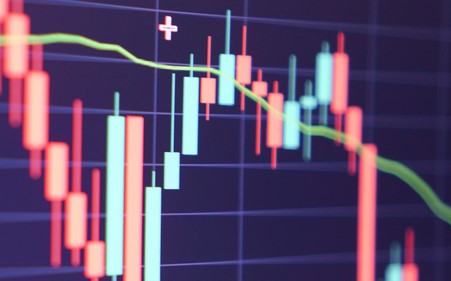Resumes trading in GM shares after announcement to sell submicron Technology

Visitors: 1118
Thus, the main US stock indexes reset the losses incurred on the premarket, which indicates significant progress in the first minutes of the meeting. After a few minutes, the US bag weakens again.
The main news came from the corporate front. Wall Street is preparing for a long weekend. Wall Street will reopen its doors next Tuesday, July 5, after a break on Monday, July 4, the day of the celebration of US Independence Day.
After 16: 00 Moscow time, the Dow Jones index fell by
30,784 points; S&P 500 rose 0.20% to 3,793. The Nasdaq recovery attempt was most supported, which rose 0.40% to 11,068 shares. But in conditions of volatility similar to the current one, sales are hidden.
The sell-off on Micron Technology shares, which trails Wall Street by more than 5% after the number one U.S. memory chip group announced a sales and earnings per share forecast for the fiscal fourth quarter, is significantly lower than analysts' estimates. The American giant warned that revenue would be $7.2 billion, well below the $9.14 billion estimated by consensus. Excluding some extraordinary balance sheet items, earnings per share will also be only $1.63, which is much lower than the $2.57 expected by analysts.
The prospects for Micron Technology contribute to concerns about the risk of a sharp slowdown in two key sectors of Micron memory chips: the computer industry and the smartphone industry.
The focus is even on the suspension name of GM's colossus car, following the company's announcement, which warned that the budget results in the second quarter would depend on issues that interested and continue to interest the supply chain, including delays in deliveries, the chip needed for the production of vehicles. However, the giant confirmed the forecast for 2022. After the suspension, the shares returned to trading with an increase of about 3%, and then decisively weakened profits.
Apple is also playing a major role after the decision of Samik Chatterjee, an analyst at J. P. Morgan Securities, who confirmed the "ultra-high" rating on the stock, adding that he is not worried about the prospects of the iPhone giant.
A senior analyst at JP Morgan's hardware networks and IT equipment division has a target price for Apple shares of $200 for December, which is $46 more than the value at which the shares closed yesterday's session.
Apple's stock price declined by almost 22% in the second quarter of 2022, suffering from a decline stronger since the fourth quarter of 2018, during a strong sell-off that it was knocked down by the stock as a whole, and in the face of outlook, which was not convinced by the market. However, Apple's stock is flat.
In that this is the first meeting in the third quarter and the second half of 2022, investors are eager to change to stocks, after the carnage in the second quarter caused in recent weeks, especially from the fear of recession. Fears that in recent sessions this was confirmed not only by the trend of stocks, but also by the trend of the US Treasury, which again became the subject of purchases. As a result, there is a reduction in rates, with ten-year-olds returning to travel below the 3% threshold, and today they are dropping to 2,805%.
It seems to have approved in the outlook of some strategists, such as Barclays, who believe that the fixed income market can return the object of purchase after the capitulation suffered, and that the stock will not touch it, but with the background.
The S&P 500 has declined from its worst half-year in more than 50 years, since 1970, with an annualized loss of -20.6%. There were also negative sessions yesterday, in the last second quarter of the year, while the US benchmark stock index, which lost almost 0.9%, at 3.785.38 points. The Dow Jones Industrial Average fell 253.88 points, or -0.8%, to 30,775.43, while the Nasdaq Composite lagged 1.3% to 11,028.74.
In the second quarter of 2022, the S&P 500 lost more than 16%, which is the worst quarter since 2020, especially since the beginning of the global Covid-19 pandemic warning. The index declined in the second quarter in a bear market, to a lower value of more than -21% than the previous record tested in early January.
The Dow Jones Industrial Average collapsed by 11.3% in the second quarter, resulting in losses since the beginning of the year of more than -15%; Nasdaq Composite suffered the worst quarter since 2008, with a crash of -22.4%, confirming the bear market phase, below almost -32% of the record tested in November 2021 and pipeline by 29.5%. and since the beginning of 2022.
Stocks have fallen in recent weeks, primarily due to fear of a hard landing in the US, which, it is feared, may be caused by a cycle of rate hikes in the US, which the Jerome Powell Fed is conducting to reduce inflation to the 2% target.
Economists and markets fear that too aggressive monetary restrictions needed by the Fed to ease inflationary pressures will eventually lead the US economy into recession.
The Fed, the Fed's monetary policy arm, will meet next July 26 to announce its rate decision, on July 27, after closing by 75 basis points at the last meeting in early June, which brought the value of money to a new range between 1.50% and 1.75%: monetary tightening has become the strongest since 1994, against inflation, who has been traveling to the US for the last 40 years.
In this regard, the publication of the report on consumption expenditures and personal income, which occurred yesterday, highlighted the slowdown in the main PCE index, the preferred parameter of the Federal Reserve System for monitoring inflation.
The fall made investors hope that inflation had finally peaked. A noticeable slowdown in consumer spending, however, weakened the already negative sentiment in the markets, supporting fears about the onset of a recession.
Year-on-year and in May, the PCE core index in the US grew by 4.7%, which is less than the + 4.8% expected by consensus, and slowed down compared to the previous growth of 4.9%.
The monthly trend increased by 0.3%, which is less than the expected +0.4%. And these figures are enough to hope that inflation is slowing down.
Instead, the headline PCE grew at an annualized rate of 6.3%, compared to April. On a monthly basis, the increase was 0.6%, accelerating from +0.2% in the previous month.
Looking at other numbers, personal income grew by 0.5% in May, as expected, while consumption expenditures, they slowed down, rising by 0.2% in May, compared with +0.9% in the previous month, below the growth expected from consensus, was +0.4%.
And this trend could be a wake-up call for the health of the American economy.
We have compiled for you a list of unscrupulous brokers, , with reviews on which you can find on our website.


Comments 0